
Opinion: Central banks are overly worried the reflation trade will fizzle
‘If ever there was a time to start withdrawing monetary stimulus, it is now’
Spare a thought for Mario Draghi.
Last Thursday, the president of the European Central Bank (ECB) warned that it would be a mistake to start discussing scaling back, or “tapering”, the central bank’s aggressive programme of quantitative easing (QE) even though the eurozone economy is now expanding at its fastest pace in six years.
Draghi, who faces mounting pressure from the “hawks” on the ECB’s governing council, led by Germany, to start winding down QE, said that although the eurozone’s recovery is “increasingly solid”, underlying inflationary pressures “remain subdued and have yet to show a convincing upward trend”.
Really?
The ECB is not alone among the world’s main central banks in fearing the consequences of taking its foot off the stimulus pedal
The day after Draghi held his press conference, Eurostat, the European statistics bureau, announced that the eurozone’s core inflation rate, which excludes volatile food and energy prices, shot up to 1.2 per cent last month, its highest level in nearly four years. While this is still significantly below the ECB’s 2 per cent target, the case for holding off on tapering QE just got even weaker.
For the German-led hawks, Draghi is not only being overly cautious, he is storing up trouble for the future: by delaying the withdrawal of monetary stimulus, Draghi is increasing the risk that the ECB falls behind the curve, possibly necessitating more aggressive action once the process of policy normalisation finally gets underway.
Yet the ECB is not alone among the world’s main central banks in fearing the consequences of taking its foot off the stimulus pedal.

At its latest policy meeting last Thursday, the Bank of Japan went to great lengths to convince financial markets that it is in no rush to taper its asset purchase programme even though Japan’s economic outlook is improving, underpinned by the sharp decline in the yen following the US presidential election. The Bank of Japan’s governor, Haruhiko Kuroda, said that to start a debate about exiting from QE at this stage “would invite confusion from the market and thus it’s premature”.
Yet is Kuroda (and Draghi, too, for that matter) correct in assuming that markets would react negatively to the withdrawal of monetary stimulus?
Or, to put it another way, who is more afraid of whom?
While international investors and traders remain acutely sensitive to the actions of the world’s main monetary guardians, they have not behaved in the ways that central bankers might have feared – indeed, quite the opposite.
Markets have been exceptionally calm in the face of a tightening in US monetary policy and mounting speculation about a tapering of QE in Europe and Japan. Global equities are hovering near record highs while the Vix index, Wall Street’s “fear gauge” that measures the anticipated volatility in the benchmark S&P 500 Index, currently stands just a whisker above its post-financial-crisis low. More remarkably, the 10-year Treasury yield has fallen 20 basis points since the Federal Reserve’s March 15 decision to raise interest rates.
Make no mistake, it is central banks that are more worried about the reaction of markets than vice versa.
If ever there was a time to start withdrawing monetary stimulus, it is now. Yet the fact that central banks, including the Fed, are wary of normalising policy too quickly even though financial volatility is at historically low levels shows the extent to which policymakers remain fearful of destabilising markets.
The Bank for International Settlements (BIS), the so-called central bankers’ bank, foresaw that such problems would arise. In its 2014 annual report, it warned that policymakers could eventually find themselves boxed in by fears of provoking a severe sell-off. “The risk of normalising [policy] too late and too gradually should not be underestimated,” the BIS cautioned.
Still, the case for central banks to err on the side of caution is a compelling one.
Core inflation still remains significantly below target in the eurozone and Japan – and only recently turned positive in the case of Japan – while the US economy has recently shown signs of weakness, with first-quarter gross domestic product expanding at its slowest pace in three years.
Just as importantly, the jury is still out on the severity of the fallout in markets from an end to years of ultra-loose monetary policy. The Fed’s rate-rising cycle is an extremely gradual one while the ECB and the Bank of Japan have not even begun withdrawing stimulus in any meaningful manner.
Just because markets are buoyant right now does not mean the exit from QE will be a smooth one. It could yet prove disorderly, as the 2013 “taper tantrum” attested all too well.
Yet by delaying the inevitable, the normalisation of monetary policy is only likely to be that much harder.
Nicholas Spiro is a partner at Lauressa Advisory

